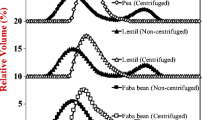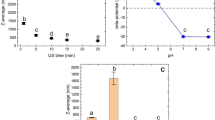Abstract
Replacement of dairy proteins by plant proteins is a current trend to produce stable colloidal systems critical to the food and beverage industry. In this study, we compared commercial samples of lentil protein concentrate (LPC) and whey protein concentrate (WPC) to stabilize ultrasound-produced sunflower oil-in-water emulsions. The effects of high-intensity ultrasound (HIUS) (0, 300, 600, 900, and 1200 W) on the LPC-stabilized emulsion properties were evaluated and compared to the emulsion stabilized by WPC, with the aim to assess the challenges and drawbacks of using LPC. Steric stabilization mechanism predominated over electrostatic mechanism. The interfacial tension results showed the ability of LPC to adsorb into the oil–water interface. HIUS processing reduced surface charge density of protein-adsorbed oil droplets, decreasing its contribution to kinetic stabilization. The mean droplet diameter of fresh emulsions showed a significant reduction from 5.44 µm at 0 W nominal power to 2.07 µm at 600 W. However, HIUS process intensification by increasing nominal power up to 1200 W increased mean droplet diameter due to starch and dietary fiber aggregation. Although LPC and WPC had distinctive technological properties due to their composition, our results demonstrated that LPC is a promising plant protein to stabilize colloidal systems.






Similar content being viewed by others
References
Silva EK, Gomes MTMS, Hubinger MD et al (2015) Ultrasound-assisted formation of annatto seed oil emulsions stabilized by biopolymers. Food Hydrocoll 47:1–13. https://doi.org/10.1016/j.foodhyd.2015.01.001
Moore P (1984) Emulsion stability, In: McClements DJ (ed) Food emulsions: principles, practices, and techniques. CRC Press, pp 289–382
Ozturk B, McClements DJ (2016) Progress in natural emulsifiers for utilization in food emulsions. Curr Opin Food Sci 7:1–6. https://doi.org/10.1016/j.cofs.2015.07.008
Hoffmann H, Reger M (2014) Emulsions with unique properties from proteins as emulsifiers. Adv Colloid Interface Sci 205:94–104. https://doi.org/10.1016/j.cis.2013.08.007
Dickinson E (2010) Flocculation of protein-stabilized oil-in-water emulsions. Colloids Surfaces B Biointerfaces 81:130–140. https://doi.org/10.1016/j.colsurfb.2010.06.033
Nylander T, Arnebrant T, Cárdenas M, Bos M (2019) Protein/emulsifier interactions. In: Hasenhuettl GHR (ed) Food emulsifiers and their applications, 2nd edn. Springer, pp 101–192
Szilagyi A, Walker C, Thomas MG (2019) Lactose intolerance and other related food sensitivities. Lactose: evolutionary role, health effects, and applications. Academic Press, Inc., pp 113–153
Avramenko NA, Low NH, Nickerson MT (2013) The effects of limited enzymatic hydrolysis on the physicochemical and emulsifying properties of a lentil protein isolate. Food Res Int 51:162–169. https://doi.org/10.1016/j.foodres.2012.11.020
Silva EK, Azevedo VM, Cunha RL et al (2016) Ultrasound-assisted encapsulation of annatto seed oil: whey protein isolate versus modified starch. Food Hydrocoll 56:71–83. https://doi.org/10.1016/j.foodhyd.2015.12.006
de Fernandes RV, B, Borges SV, Silva EK, et al (2016) Study of ultrasound-assisted emulsions on microencapsulation of ginger essential oil by spray drying. Ind Crops Prod 94:413–423. https://doi.org/10.1016/j.indcrop.2016.09.010
Albano KM, Nicoletti VR (2018) Ultrasound impact on whey protein concentrate-pectin complexes and in the O/W emulsions with low oil soybean content stabilization. Ultrason Sonochem 41:562–571. https://doi.org/10.1016/j.ultsonch.2017.10.018
Huerta RR, Silva EK, Ekaette I et al (2020) High-intensity ultrasound-assisted formation of cellulose nanofiber scaffold with low and high lignin content and their cytocompatibility with gingival fibroblast cells. Ultrason Sonochem 64:104759. https://doi.org/10.1016/j.ultsonch.2019.104759
Ojha KS, Mason TJ, O’Donnell CP et al (2017) Ultrasound technology for food fermentation applications. Ultrason Sonochem 34:410–417. https://doi.org/10.1016/j.ultsonch.2016.06.001
Abbasi F, Samadi F, Jafari SM et al (2019) Ultrasound-assisted preparation of flaxseed oil nanoemulsions coated with alginate-whey protein for targeted delivery of omega-3 fatty acids into the lower sections of gastrointestinal tract to enrich broiler meat. Ultrason Sonochem 50:208–217. https://doi.org/10.1016/j.ultsonch.2018.09.014
Huerta RR, Silva EK, El-Bialy T, Saldaña MDA (2020) Clove essential oil emulsion-filled cellulose nanofiber hydrogel produced by high-intensity ultrasound technology for tissue engineering applications. Ultrason Sonochem 64:104845. https://doi.org/10.1016/j.ultsonch.2019.104845
Ma W, Wang J, Xu X et al (2019) Ultrasound treatment improved the physicochemical characteristics of cod protein and enhanced the stability of oil-in-water emulsion. Food Res Int 121:247–256. https://doi.org/10.1016/j.foodres.2019.03.024
Taha A, Hu T, Zhang Z et al (2018) Effect of different oils and ultrasound emulsification conditions on the physicochemical properties of emulsions stabilized by soy protein isolate. Ultrason Sonochem 49:283–293. https://doi.org/10.1016/j.ultsonch.2018.08.020
Karaca AC, Low N, Nickerson M (2011) Emulsifying properties of chickpea, faba bean, lentil and pea proteins produced by isoelectric precipitation and salt extraction. Food Res Int 44:2742–2750. https://doi.org/10.1016/j.foodres.2011.06.012
Gumus CE, Decker EA, McClements DJ (2017) Formation and stability of ω-3 oil emulsion-based delivery systems using plant proteins as emulsifiers: Lentil, pea, and faba bean proteins. Food Biophys 12:186–197. https://doi.org/10.1007/s11483-017-9475-6
Silva EK, Arruda HS, Pastore GM et al (2020) Xylooligosaccharides chemical stability after high-intensity ultrasound processing of prebiotic orange juice. Ultrason Sonochem 63:104942. https://doi.org/10.1016/j.ultsonch.2019.104942
Mason TJ, Lorimer JP, Bates DM, Zhao Y (1994) Dosimetry in sonochemistry: the use of aqueous terephthalate ion as a fluorescence monitor. Ultrason Sonochem 1:2–6. https://doi.org/10.1016/1350-4177(94)90004-3
Billmeyer FW, Hammond HK (1990) ASTM standards on color-difference measurements. Color Res Appl 15:206–209. https://doi.org/10.1002/col.5080150406
Pearce KN, Kinsella JE (1978) Emulsifying properties of proteins: evaluation of a turbidimetric technique. J Agric Food Chem 26:716–723. https://doi.org/10.1021/jf60217a041
Joshi M, Adhikari B, Aldred P et al (2012) Interfacial and emulsifying properties of lentil protein isolate. Food Chem 134:1343–1353. https://doi.org/10.1016/j.foodchem.2012.03.029
Jafari SM, Beheshti P, Assadpoor E (2012) Rheological behavior and stability of d-limonene emulsions made by a novel hydrocolloid (Angum gum) compared with Arabic gum. J Food Eng 109:1–8. https://doi.org/10.1016/j.jfoodeng.2011.10.016
Joshi M, Adhikari B, Aldred P et al (2011) Physicochemical and functional properties of lentil protein isolates prepared by different drying methods. Food Chem 129:1513–1522. https://doi.org/10.1016/j.foodchem.2011.05.131
Chang C, Tu S, Ghosh S, Nickerson MT (2015) Effect of pH on the inter-relationships between the physicochemical, interfacial and emulsifying properties for pea, soy, lentil and canola protein isolates. Food Res Int 77:360–367. https://doi.org/10.1016/j.foodres.2015.08.012
Ladjal-Ettoumi Y, Boudries H, Chibane M, Romero A (2016) Pea, chickpea and lentil protein isolates: physicochemical characterization and emulsifying properties. Food Biophys 11:43–51. https://doi.org/10.1007/s11483-015-9411-6
Morr CV, Ha EYW (1993) Whey protein concentrates and isolates: processing and functional properties. Crit Rev Food Sci Nutr 33:431–476. https://doi.org/10.1080/10408399309527643
Dickinson E, Radford SJ, Golding M (2003) Stability and rheology of emulsions containing sodium caseinate: combined effects of ionic calcium and non-ionic surfactant. Food Hydrocoll 17:211–220. https://doi.org/10.1016/S0268-005X(02)00055-3
McClements DJ (2007) Critical review of techniques and methodologies for characterization of emulsion stability. Crit Rev Food Sci Nutr 47:611–649. https://doi.org/10.1080/10408390701289292
Acedo-Carrillo JI, Rosas-Durazo A, Herrera-Urbina R et al (2006) Zeta potential and drop growth of oil in water emulsions stabilized with mesquite gum. Carbohydr Polym 65:327–336. https://doi.org/10.1016/j.carbpol.2006.01.016
Jafari SM, He Y, Bhandari B (2007) Production of sub-micron emulsions by ultrasound and microfluidization techniques. J Food Eng 82:478–488. https://doi.org/10.1016/j.jfoodeng.2007.03.007
Kaltsa O, Michon C, Yanniotis S, Mandala I (2013) Ultrasonic energy input influence on the production of sub-micron o/w emulsions containing whey protein and common stabilizers. Ultrason Sonochem 20:881–891. https://doi.org/10.1016/j.ultsonch.2012.11.011
Koocheki A, Kadkhodaee R, Mortazavi SA et al (2009) Influence of Alyssum homolocarpum seed gum on the stability and flow properties of O/W emulsion prepared by high intensity ultrasound. Food Hydrocoll 23:2416–2424. https://doi.org/10.1016/j.foodhyd.2009.06.021
Aslan D, Dogan M (2018) The influence of ultrasound on the stability of dairy-based, emulsifier-free emulsions: rheological and morphological aspect. Eur Food Res Technol 244:409–421. https://doi.org/10.1007/s00217-017-2966-3
Dalgleish DG (1997) Adsorption of protein and the stability of emulsions. Trends Food Sci Technol 8:1–6. https://doi.org/10.1016/S0924-2244(97)01001-7
McClements DJ (2002) Colloidal basis of emulsion color. Curr Opin Colloid Interface Sci 7:451–455. https://doi.org/10.1016/S1359-0294(02)00075-4
Chantrapornchai W, Clydesdale F, McClements DJ (1999) Influence of droplet characteristics on the optical properties of colored oil-in-water emulsions. Colloids Surfaces A Physicochem Eng Asp 155:373–382. https://doi.org/10.1016/S0927-7757(99)00004-7
Acknowledgements
We would like to acknowledge the Natural Sciences and Engineering Research Council of Canada (NSERC, #04371-2019) and the vitamin research fund at the University of Alberta for funding this research. Eric Keven Silva thanks FAPESP (2018/14550-6) for his postdoctoral assistantship at the University of Alberta. The authors thank Dr. Mehmet C. Tulbek from AGT Foods (Saskatoon, SK, Canada) for providing the lentil protein concentrate, and Dr. Xu at the University of Alberta for allowing us to use the optical tensiometer.
Author information
Authors and Affiliations
Corresponding author
Ethics declarations
Conflict of interest
The authors confirm that there are no known conflicts of interest associated with this publication.
Additional information
Publisher's Note
Springer Nature remains neutral with regard to jurisdictional claims in published maps and institutional affiliations.
Rights and permissions
About this article
Cite this article
Mekala, S., Silva, E.K. & Saldaña, M.D.A. Mechanism, kinetics, and physicochemical properties of ultrasound-produced emulsions stabilized by lentil protein: a non-dairy alternative in food systems. Eur Food Res Technol 248, 185–196 (2022). https://doi.org/10.1007/s00217-021-03871-2
Received:
Revised:
Accepted:
Published:
Issue Date:
DOI: https://doi.org/10.1007/s00217-021-03871-2




